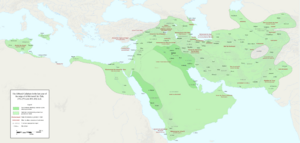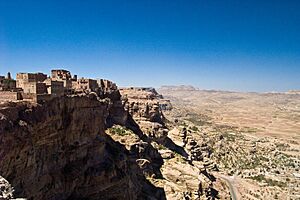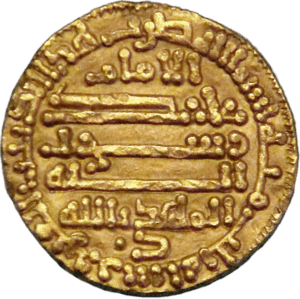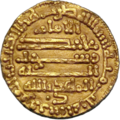Ibn Hawshab facts for kids
Ibn Hawshab (died 31 December 914), also known as Mansur al-Yaman (meaning 'Conqueror of Yemen'), was an important Isma'ili missionary. He came from a town near Kufa in Iraq.
Working with another missionary named Ali ibn al-Fadl al-Jayshani, Ibn Hawshab helped spread the Isma'ili faith in Yemen. They conquered much of the country in the late 800s and early 900s. They did this for the Isma'ili leader, Abdallah al-Mahdi, who was in hiding at the time.
In 909, al-Mahdi publicly announced himself in Ifriqiya (modern-day Tunisia) and started the Fatimid Caliphate. After this, Ibn al-Fadl turned against al-Mahdi. This forced Ibn Hawshab into a less powerful role. We know about Ibn Hawshab's life from a book he wrote about himself. Later Isma'ili writings also say he wrote two religious books.
Contents
Early Life and Becoming an Isma'ili
Ibn Hawshab was born in a village near the Nahr Nars canal, close to Kufa in southern Iraq. We don't know much about his family background. Some later stories say he was a descendant of Muslim ibn Aqil ibn Abi Talib, who was a nephew of Ali ibn Abi Talib.
Sources describe him as either a linen weaver or a carpenter. His family followed a branch of Islam called Twelver Shi'ism. According to Ibn Hawshab, he had a crisis of faith around 874. This was after the eleventh imam, Hasan al-Askari, died without a clear male heir.
The Search for a Mahdi
Eventually, Twelvers came to believe that al-Askari had a baby son who was the twelfth and hidden imam. They believed this hidden imam would one day return as the mahdī. The Mahdi is a special leader in Islamic belief who will bring justice and peace. He is expected to defeat the Abbasid caliphs, unite Muslims, and make Islam triumph.
However, this belief was not strong right after Hasan al-Askari's death. Many Shi'ites, like Ibn Hawshab, had doubts. They were also disappointed by the Twelver leaders, who seemed to have little political power.
Finding the Isma'ili Faith
In this time of uncertainty, the Isma'ilis offered an appealing message. They also believed in the imminent return of a mahdī. They preached that a new era of justice and true religion was about to begin. This message attracted many unhappy Twelvers.
Ibn Hawshab said he became an Isma'ili after an old man approached him while he was studying the Quran by the Euphrates river. After his training, he was given the important job of spreading the Isma'ili faith in Yemen. He traveled with Ali ibn al-Fadl al-Jayshani, a Yemeni who had recently converted. They set off in May or June 881.
Mission to Yemen
The two missionaries first went to Kufa. From there, they joined pilgrim caravans. These large groups of travelers from all over the Islamic world allowed them to travel without being noticed. After completing their pilgrimage rituals in Mecca, they arrived in northern Yemen in August 881.
Yemen's Political Landscape
At that time, Yemen was a troubled province of the Abbasid empire. The central government's power was weak, mostly limited to the capital, Sana'a. The rest of the country was filled with tribal conflicts. When Ibn Hawshab and Ibn al-Fadl arrived, Yemen was politically divided. It was only loosely under Abbasid rule.
Many different groups controlled parts of the country. The Yu'firid dynasty held much of the interior. The Ziyadids controlled the western coast. Other families and warring tribes ruled different regions. This lack of unity, along with the remote terrain and local Shi'a sympathies, made Yemen a good place for a strong leader to gain power.
Starting the Mission
After traveling through Sana'a and al-Janad, Ibn Hawshab stayed in Aden for a while. He pretended to be a cotton merchant. Ibn Hawshab was clearly the more senior of the two missionaries. However, Ali ibn al-Fadl eventually left him. Ibn al-Fadl went to his hometown of Jayshan and began his own mission in the mountains.
Ibn Hawshab didn't have much success in Aden. But he met some Shi'a members of the northern Banu Musa clan. They liked his teachings and invited him to their homeland. So, he left Aden and settled in Adan La'a, a village west of Sana'a. There, he married the orphaned daughter of a Shi'a supporter who had died in prison. In 883/4, he began his public mission, announcing that the mahdī would soon appear.
Growing Influence
His message quickly attracted many followers. People were expecting a new era, and the Abbasid Caliphate was facing a deep crisis. Many Twelvers were also unhappy. All these factors made the revolutionary Isma'ili message very appealing.
Ibn Hawshab quickly gained many converts. His wife's family were among the first. One of her cousins, al-Haytham, was sent as a missionary to Sindh (part of modern-day Pakistan). This was the start of a long Isma'ili presence in India. Other missionaries were sent to Egypt, Bahrayn, and other parts of India.
One of the most important missionaries trained by Ibn Hawshab was Abu Abdallah al-Shi'i. He was from Sana'a. In 893, Ibn Hawshab sent him to the Maghreb (North Africa). There, he began spreading the Isma'ili faith among the Kutama Berbers. His mission was very successful. With the Kutama's support, he led a revolt against the Aghlabid rulers in 903. This led to the overthrow of the Aghlabids and the establishment of the Fatimid Caliphate in 909.
Building Strongholds
By 885, the Isma'ili movement was strong enough for Ibn Hawshab to ask for permission to raise an army. He wanted to openly fight for power. In 885/6, after fighting off an attack by local troops, Ibn Hawshab and his followers built a strong fort at Abr Muharram. This was at the base of the Jabal Maswar mountains, northwest of Sana'a. It's said that 500 men built the fort in seven days. Ibn Hawshab and fifty of his most important followers lived there. A few days later, they moved to Jabal al-Jumayma mountain.
From this base, his forces captured Bayt Fa'iz at Jabal Tukhla. This was a fortress that controlled the Maswar area. It fell when Ibn Hawshab convinced some of the soldiers guarding it to switch sides. The fortress of Bayt Rayb, which was very well protected, was captured on the third try. It soon became Ibn Hawshab's main home and stronghold. He called it dār al-hijra, meaning 'place of refuge'. This name was a deliberate echo of the exile of Muhammad and his first followers from Mecca to Medina. It suggested that those who joined Ibn Hawshab were leaving a corrupt world to create a purer faith, just like the first Muslims.
These three strong fortresses gave Ibn Hawshab a secure area. From there, he began to expand his control over nearby valleys and mountains. He captured Jabal Tays mountain and appointed a missionary named Abu'l-Malahim as governor. He also captured the areas of Bilad Shawir, Ayyan, and Humlan.
Ibn Hawshab's first attack on the Yu'firid capital, Shibam, failed. But he soon captured it thanks to betrayal from inside the city walls. However, he was forced to leave it after only a month. We don't know the exact dates of these events, but by 892/3, his position was very strong. This earned him the title Manṣūr al-Yaman, meaning 'the Conqueror of Yemen'.
Expansion and Conflict with Ibn al-Fadl
Meanwhile, Ibn Hawshab's fellow missionary, Ali ibn al-Fadl, had gained the support of the local ruler of al-Mudhaykhira. With this help, he expanded his control over the highlands north of Aden. At the same time, in 897, another Shi'a leader arrived in Yemen. This was al-Hadi ila'l-Haqq Yahya, a leader of the rival Zaydi sect. He established a state in Sa'ada and became its imam.
Originally, Isma'ilis believed the expected mahdī was Muhammad ibn Isma'il. However, in 899, the Isma'ili movement split. A group called the Qarmatians rejected the secret leadership in Salamiya. This happened when Abdallah al-Mahdi, who would later found the Fatimid Caliphate, said that Muhammad ibn Isma'il would not return. Instead, he declared himself to be the mahdī. Both Ibn Hawshab and Ibn al-Fadl remained loyal to al-Mahdi.
Abdallah al-Mahdi was soon forced to flee Salamiya. In 905, he considered moving to Yemen or the Maghreb. Both places had successful Isma'ili missions. Some historians suggest that doubts about Ibn al-Fadl's loyalty might have influenced al-Mahdi's decision to choose the Maghreb.
Growing Tensions
On 25 January 905, Ibn al-Fadl drove his former ally out of al-Mudhaykhira. The two Isma'ili leaders then used the country's political divisions to expand their own territories. In November 905, Ibn al-Fadl captured Sana'a. This allowed Ibn Hawshab to take Shibam. With the exception of Zaydi-held Sa'ada in the north, Ziyadid-ruled Zabid on the western coast, and Aden in the south, most of Yemen was now under Isma'ili control.
In late 905, for the first time in 25 years, the two men met in Shibam. Historians say the meeting was "uneasy." Ibn Hawshab warned Ibn al-Fadl not to spread his forces too thin, but Ibn al-Fadl ignored him. Ibn al-Fadl was more active in the following years, campaigning against those who opposed the Isma'ili movement. But when he raided al-Bayad, Ibn Hawshab had to support him.
Both Sana'a and Shibam were briefly lost to the Zaydi imam al-Hadi in 906. But Shibam was recovered that same year, and Sana'a in April 907. In June/July 910, after the Zaydis again occupied Sana'a and then left, Ibn Hawshab's men briefly took the city. But they couldn't hold it because they had too few soldiers. Instead, the city fell to the Yu'firid leader As'ad ibn Ibrahim. Then Ibn al-Fadl took it again in August 911.
The Final Break
At this point, Ibn al-Fadl publicly announced that he no longer supported Abdallah al-Mahdi. Al-Mahdi had revealed himself after Abu Abdallah al-Shi'i's successes and the establishment of the Fatimid Caliphate in 909. Now, Ibn al-Fadl declared himself to be the awaited mahdī.
Ibn Hawshab refused to join Ibn al-Fadl and criticized his actions. So, Ibn al-Fadl marched against Ibn Hawshab. Shibam and Jabal Dhukhar were captured. After a few battles, Ibn Hawshab was trapped in Jabal Maswar. After an eight-month siege, in April 912, Ibn Hawshab agreed to terms. He handed over his son Ja'far as a hostage. Ja'far was returned a year later with a golden necklace as a gift.
Death and What Happened Next
Ibn Hawshab died on 31 December 914. Ibn al-Fadl died soon after, in October 915. Both men were replaced by their sons. However, their power quickly declined. Ibn al-Fadl's territory was soon destroyed by the Yu'firids.
For over a hundred years, until the Sulayhid dynasty rose to power, Isma'ilism in Yemen remained mostly a secret movement. Ibn Hawshab's three sons were removed from leadership by the missionary Shawiri. One of his sons, Ja'far, fled to the Fatimid court in Ifriqiya. He took his father's writings with him and became an important writer himself during the early Fatimid period. Despite these challenges, the Isma'ili community founded by Ibn Hawshab in northern Yemen survived. It has been a key part of the continued existence of Isma'ilism in Yemen to this day.
Writings
We know a lot about Ibn Hawshab's life from a book called Life (Sīra). It was written either by him or by his son, Ja'far. This book is now lost, but parts of it are quoted in later writings. Historian Heinz Halm says it is "one of the most important sources for the history of the daʿwa" (the Isma'ili mission).
Later Isma'ili tradition says he wrote two of the earliest Isma'ili religious books. The first, the Book of Righteousness and True Guidance (Kitāb al-Rushd wa’l-hidāya), only exists in fragments. These fragments have been published. The book explains parts of the Quran. It is one of the oldest Isma'ili works that still mentions Muhammad ibn Isma'il as the awaited mahdī.
The second book, the Book of the Sage and Disciple (Kitāb al-ʿĀlim wa’l-ghulām), is usually said to be written by his son, Ja'far. It describes conversations between a new student and his spiritual guide (the missionary). The guide slowly reveals secret, hidden knowledge to his student. We are not completely sure if Ibn Hawshab wrote either of these books. A 12th-century Yemeni missionary, Ibrahim al-Hamidi, also quotes a letter (risāla) that he says was written by Ibn Hawshab.
See also
- Islamic history of Yemen
- Shia Islam in Yemen
Images for kids







